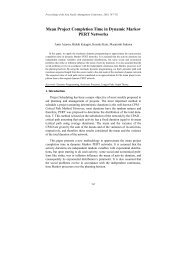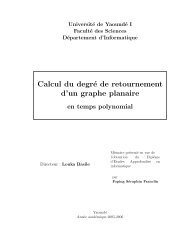Models for Global Constraint Applications - Cork Constraint ...
Models for Global Constraint Applications - Cork Constraint ...
Models for Global Constraint Applications - Cork Constraint ...
Create successful ePaper yourself
Turn your PDF publications into a flip-book with our unique Google optimized e-Paper software.
cost or passenger movements. A typical rule is to minimise the number of passengers<br />
that have to be transported with buses. But many of the preferences<br />
are perceived differently by different stake-holders in the operations: Competing<br />
airlines only consider their own flights, <strong>for</strong> which they expect preferential<br />
treatment by the airport. Ground operations may complain about resource<br />
requirements, even if passenger satisfaction increases.<br />
Another aspect of the allocation problem is that planes only directly compete<br />
<strong>for</strong> resources if their stay at the airport overlaps in time. The stand allocation<br />
system is not allowed to shift flights in time, but must take arrival and departure<br />
times as given. When delays, cancellations or early arrivals change the set of<br />
planes to be handled, the problem must be resolved incrementally. Much of the<br />
current assignment can no longer be changed, since planes are already parked,<br />
or passengers have been told about a gate assignment. Some of the changes<br />
may create additional cost, which has to be balanced against smooth operations<br />
without causing delays to flights.<br />
How difficult is this problem? If every plane can be placed on every stand,<br />
then it reduces to graph colouring in an interval graph, <strong>for</strong> which easy polynomial<br />
algorithms are sufficient. If the possible stands <strong>for</strong> the planes are more<br />
restricted, then the problem becomes hard. But problem sizes are often quite<br />
manageable with planes and stands in the low hundreds. Except <strong>for</strong> extreme<br />
situations, there are normally enough stands to place all aircraft somewhere<br />
on the apron. On the other hand operational costs and delays may increase<br />
dramatically if direct gate connections are not used well. Since the number of<br />
buses and drivers is limited, these resource constraints will create a bottleneck<br />
if many planes are placed on the apron.<br />
An important consideration in solving this problem effectively is the question<br />
whether it can be decomposed into smaller, independent subproblems. Most<br />
large airports consist of multiple terminals, which are largely run as independent<br />
operations. If at all possible, the overall stand allocation problem should be<br />
decomposed into allocation problems <strong>for</strong> individual terminals, each dealing with<br />
its own set of constraints. Any interaction between the problems (<strong>for</strong> example<br />
“borrowing” a stand at a different terminal <strong>for</strong> a period of time), would then<br />
be treated as a temporary modification of the sub problems.<br />
2.2 Model<br />
We present three different models <strong>for</strong> this application type, starting with a naive<br />
binary constraint model, which is easily changed into a model using multiple<br />
alldifferent constraints and finally a model using a single diffn constraint. We<br />
begin with some problem definitions.<br />
The set of all planes to be allocated is denoted by I. For a plane i, we<br />
are given fixed arrival and departure times si and ei, defining the duration<br />
di of the stay at the airport. The possible return of a plane to the airport<br />
later on in the day is considered to create another, independent instance of a<br />
parking demand. The set Pi defines the set of all possible parking positions <strong>for</strong><br />
plane i, which typically is derived by a complex rule set from flight in<strong>for</strong>mation<br />
data and operational rules of the airport. For every possible stand assignment,<br />
we also can define operational costs Ci : Pi ↦→ N and assignment preferences<br />
Qi : Pi ↦→ N which are given by extension. As cost we can <strong>for</strong> example count<br />
how many passengers would need to be transported by bus, if the plane is not<br />
5









